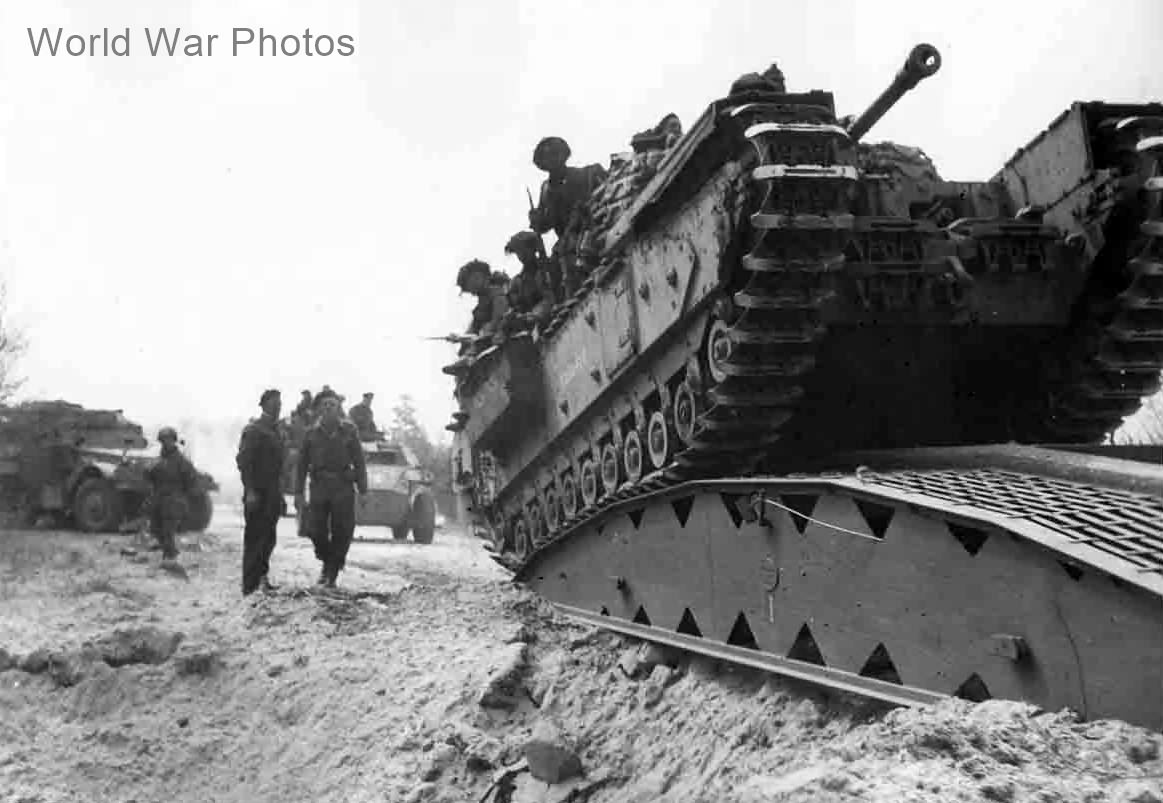The British Army Churchill regiments played a critical role during World War II, especially in supporting infantry divisions in close cooperation with infantry tanks. Here’s an overview of their structure, organization, and deployment:
Organization of Churchill Regiments
Churchill regiments were part of the Army Tank Brigades, each comprised of three Infantry Tank Regiments equipped with Churchill tanks. These regiments were organized as follows:
- Regimental Command:
- Commanded by a lieutenant-colonel with a major as the second-in-command.
- Three Sabre Squadrons (A, B, and C Squadrons):
- Each squadron was led by a major, with captains serving as second-in-command.
Regimental Headquarters (RHQ) Squadron
The HQ Squadron consisted of several specialized troops:
- RHQ Troop:
- 4 Churchill tanks and 1 armoured command vehicle.
- Reconnaissance Troop:
- 11 Stuart light tanks.
- Link Troop:
- 10 Dingo or Humber Scout Cars.
- Anti-Aircraft Troop:
- 6 Crusader AA tanks (equipped with 20mm anti-aircraft guns).
Sabre Squadrons
Each Sabre Squadron had:
- Squadron HQ Troop:
- 1 Churchill tank, 2 Churchill CS tanks (with 95mm close-support howitzers), and 1 Churchill ARV (armoured recovery vehicle).
- Five Churchill Troops:
- Each troop had 3 Churchill tanks.
Attachments and Support
- Observation Post (OP) Tanks:
- 8 Churchill OP tanks with Royal Artillery Forward Observation Officers were assigned to each brigade, usually 1 per squadron.
- Churchill Bridge-layers:
- 3 Churchill bridge-layers were held centrally at the brigade level as a resource for crossing obstacles.
Echelons
- A Echelon:
- This echelon consisted of trucks assigned to each squadron for resupplying fuel, ammunition, and rations. It also included medical officers (with armoured half-tracks) and Royal Electrical and Mechanical Engineers (REME) for field repairs.
- B Echelon:
- This echelon carried baggage, field kitchens, and officers’ mess trucks, coming forward only when units were out of the front line.
Crew Rest: Sometimes tank crewmen were rotated to rear-echelon duty after heavy combat, though these duties were still dangerous, as they involved driving trucks with fuel and ammunition close to enemy artillery.
Armament and Equipment
Each regiment had:
- 58 Churchill gun tanks or CS (close support) tanks.
- 11 light tanks (Stuart).
- 6 AA tanks (Crusader). The regiment had 38 officers and 670 other ranks.
Deployment and Doctrine
Churchill regiments were usually split up during operations, with each squadron assigned to support a battalion of infantry. Each three-tank troop often worked with an infantry company. Ideally, the same tanks would support the same infantry to build cohesion, but British doctrine often prevented this level of consistency.
In addition, M10 tank destroyers with 3in. or 17-pdr guns were frequently attached to Churchill squadrons for anti-tank support, similar to how Firefly Shermans supported cruiser tank regiments.
Armored Brigades in Normandy
Three Army Tank Brigades equipped with Churchills fought in the Normandy campaign:
- 34th Tank Brigade:
- Comprised 147th, 107th, and 153rd Regiments, Royal Armoured Corps (RAC). The brigade began landing in Normandy on 16 June 1944 (D+10), with all elements in place by early July.
- 31st Tank Brigade:
- Included 7th and 9th Royal Tank Regiments (RTR), and the 141st Regiment RAC, which operated Churchill Crocodiles (flame-throwing tanks). The brigade landed on 19 June 1944 (D+13).
- 6th Guards Tank Brigade:
- Consisted of the 4th Battalion Grenadier Guards, 4th Battalion Coldstream Guards, and 3rd Battalion Scots Guards. This unit landed later, on 20 July 1944 (D+44).
Specialized Units
- 1st Assault Brigade, Royal Engineers:
- This brigade operated Churchill AVREs (Armoured Vehicle Royal Engineers), which landed in the initial D-Day waves on 6 June 1944. These specialist vehicles were typically attached to other units in small numbers for specific engineering tasks, such as demolishing fortifications.
Operational Challenges
- By the end of the Normandy campaign, some regiments had disbanded their anti-aircraft troops due to the reduced air threat from the Luftwaffe, reassigning AA crews as replacements for combat casualties.
